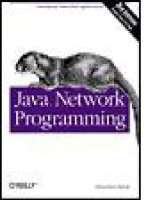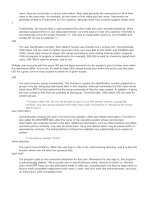OReilly TCPIP network administration 3rd edition apr 2002 ISBN 0596002971
Bạn đang xem bản rút gọn của tài liệu. Xem và tải ngay bản đầy đủ của tài liệu tại đây (6.19 MB, 1,373 trang )
Tableof
•
Contents
• Index
• Reviews
Reader
•
Reviews
• Errata
TCP/IPNetworkAdministration,3rd
Edition
ByCraigHunt
Publisher :O'Reilly
PubDate :April2002
ISBN :0-596-00297-1
Pages :746
Slots :1
Thiscompletehands-onguidetosettingupandrunninga
TCP/IPnetworkstartswiththefundamentals:what
protocolsdoandhowtheywork,howaddressesand
routingareused,andhowtosetupyournetwork
connection.Thebookalsocoversadvancedrouting
protocolsandprovidestutorialsonconfiguringimportant
networkservices.Theexpandedthirdeditionincludes
sectionsonSamba,Apachewebserver,networksecurity,
andmuchmore.
TCP/IPNetworkAdministration,3rd
Edition
ByCraigHunt
Tableof
•
Publisher :O'Reilly
Contents PubDate :April2002
• Index
ISBN :0-596-00297-1
Pages :746
• Reviews
Slots :1
Reader
•
Reviews
• Errata
Copyright
Dedication
Preface
Audience
Organization
UnixVersions
Conventions
We'dLiketoHearfromYou
Acknowledgments
Chapter1.OverviewofTCP/IP
Section1.1.TCP/IPandtheInternet
Section1.2.ADataCommunicationsModel
Section1.3.TCP/IPProtocolArchitecture
Section1.4.NetworkAccessLayer
Section1.5.InternetLayer
Section1.6.TransportLayer
Section1.7.ApplicationLayer
Section1.8.Summary
Chapter2.DeliveringtheData
Section2.1.Addressing,Routing,andMultiplexing
Section2.2.TheIPAddress
Section2.3.InternetRoutingArchitecture
Section2.4.TheRoutingTable
Section2.5.AddressResolution
Section2.6.Protocols,Ports,andSockets
Section2.7.Summary
Chapter3.NetworkServices
Section3.1.NamesandAddresses
Section3.2.TheHostTable
Section3.3.DNS
Section3.4.MailServices
Section3.5.FileandPrintServers
Section3.6.ConfigurationServers
Section3.7.Summary
Chapter4.GettingStarted
Section4.1.ConnectedandNon-ConnectedNetworks
Section4.2.BasicInformation
Section4.3.PlanningRouting
Section4.4.PlanningNamingService
Section4.5.OtherServices
Section4.6.InformingtheUsers
Section4.7.Summary
Chapter5.BasicConfiguration
Section5.1.KernelConfiguration
Section5.2.StartupFiles
Section5.3.TheInternetDaemon
Section5.4.TheExtendedInternetDaemon
Section5.5.Summary
Chapter6.ConfiguringtheInterface
Section6.1.TheifconfigCommand
Section6.2.TCP/IPOveraSerialLine
Section6.3.InstallingPPP
Section6.4.Summary
Chapter7.ConfiguringRouting
Section7.1.CommonRoutingConfigurations
Section7.2.TheMinimalRoutingTable
Section7.3.BuildingaStaticRoutingTable
Section7.4.InteriorRoutingProtocols
Section7.5.ExteriorRoutingProtocols
Section7.6.GatewayRoutingDaemon
Section7.7.Configuringgated
Section7.8.Summary
Chapter8.ConfiguringDNS
Section8.1.BIND:UnixNameService
Section8.2.ConfiguringtheResolver
Section8.3.Configuringnamed
Section8.4.Usingnslookup
Section8.5.Summary
Chapter9.LocalNetworkServices
Section9.1.TheNetworkFileSystem
Section9.2.SharingUnixPrinters
Section9.3.UsingSambatoShareResourceswithWindows
Section9.4.NetworkInformationService
Section9.5.DHCP
Section9.6.ManagingDistributedServers
Section9.7.PostOfficeServers
Section9.8.Summary
Chapter10.sendmail
Section10.1.sendmail'sFunction
Section10.2.RunningsendmailasaDaemon
Section10.3.sendmailAliases
Section10.4.Thesendmail.cfFile
Section10.5.sendmail.cfConfigurationLanguage
Section10.6.RewritingtheMailAddress
Section10.7.Modifyingasendmail.cfFile
Section10.8.Testingsendmail.cf
Section10.9.Summary
Chapter11.ConfiguringApache
Section11.1.InstallingApacheSoftware
Section11.2.ConfiguringtheApacheServer
Section11.3.Understandinganhttpd.confFile
Section11.4.WebServerSecurity
Section11.5.ManagingYourWebServer
Section11.6.Summary
Chapter12.NetworkSecurity
Section12.1.SecurityPlanning
Section12.2.UserAuthentication
Section12.3.ApplicationSecurity
Section12.4.SecurityMonitoring
Section12.5.AccessControl
Section12.6.Encryption
Section12.7.Firewalls
Section12.8.WordstotheWise
Section12.9.Summary
Chapter13.TroubleshootingTCP/IP
Section13.1.ApproachingaProblem
Section13.2.DiagnosticTools
Section13.3.TestingBasicConnectivity
Section13.4.TroubleshootingNetworkAccess
Section13.5.CheckingRouting
Section13.6.CheckingNameService
Section13.7.AnalyzingProtocolProblems
Section13.8.ProtocolCaseStudy
Section13.9.Summary
AppendixA.PPPTools
SectionA.1.Dial-UpIP
SectionA.2.ThePPPDaemon
SectionA.3.chat
AppendixB.AgatedReference
SectionB.1.ThegatedCommand
SectionB.2.ThegatedConfigurationLanguage
SectionB.3.DirectiveStatements
SectionB.4.TraceStatements
SectionB.5.OptionsStatements
SectionB.6.InterfaceStatements
SectionB.7.DefinitionStatements
SectionB.8.ProtocolStatements
SectionB.9.staticStatements
SectionB.10.ControlStatements
SectionB.11.AggregateStatements
AppendixC.AnamedReference
SectionC.1.ThenamedCommand
SectionC.2.named.confConfigurationCommands
SectionC.3.ZoneFileRecords
AppendixD.AdhcpdReference
SectionD.1.Compilingdhcpd
SectionD.2.ThedhcpdCommand
SectionD.3.Thedhcpd.confConfigurationFile
AppendixE.AsendmailReference
SectionE.1.Compilingsendmail
SectionE.2.ThesendmailCommand
SectionE.3.m4sendmailMacros
SectionE.4.Moresendmail.cf
AppendixF.Solarishttpd.confFile
AppendixG.RFCExcerpts
SectionG.1.IPDatagramHeader
SectionG.2.TCPSegmentHeader
SectionG.3.ICMPParameterProblemMessageHeader
SectionG.4.RetrievingRFCs
Colophon
Index
Copyright©2002,1998,1992CraigHunt.Allrightsreserved.
PrintedintheUnitedStatesofAmerica.
PublishedbyO'Reilly&Associates,Inc.,1005GravensteinHighway
North,Sebastopol,CA95472.
O'Reilly&Associatesbooksmaybepurchasedforeducational,
business,orsalespromotionaluse.Onlineeditionsarealsoavailablefor
mosttitles().Formoreinformationcontactour
corporate/institutionalsalesdepartment:800-998-9938or
TheO'ReillylogoisaregisteredtrademarkofO'Reilly&Associates,Inc.
Manyofthedesignationsusedbymanufacturersandsellersto
distinguishtheirproductsareclaimedastrademarks.Wherethose
designationsappearinthisbook,andO'Reilly&Associates,Inc.was
awareofatrademarkclaim,thedesignationshavebeenprintedincaps
orinitialcaps.TheassociationbetweenthelandcrabandTCP/IP
networkadministrationisatrademarkofO'Reilly&Associates,Inc.
Whileeveryprecautionhasbeentakeninthepreparationofthisbook,
thepublisherandtheauthorassumenoresponsibilityforerrorsor
omissions,orfordamagesresultingfromtheuseoftheinformation
containedherein.
Dedication
ToAlana,thebeginningofanewlife.
Preface
ThefirsteditionofTCP/IPNetworkAdministrationwaswrittenin1992.In
thedecadesince,manythingshavechanged,yetsomethingsremain
thesame.TCP/IPisstillthepreeminentcommunicationsprotocolfor
linkingtogetherdiversecomputersystems.Itremainsthebasisof
interoperabledatacommunicationsandglobalcomputernetworking.The
underlyingInternetProtocol(IP),TransmissionControlProtocol,and
UserDatagramProtocol(UDP)areremarkablyunchanged.Butchange
hascomeinthewayTCP/IPisusedandhowitismanaged.
Aclearsymbolofthischangeisthefactthatmymother-in-lawhasa
TCP/IPnetworkconnectioninherhomethatsheusestoexchange
electronicmail,compressedgraphics,andhypertextdocumentswith
otherseniorcitizens.Shethinksofthisas"justbeingontheInternet,"but
thetruthisthathersmallsystemcontainsafunctioningTCP/IPprotocol
stack,managesadynamicallyassignedIPaddress,andhandlesdata
typesthatdidnotevenexistadecadeago.
In1991,TCP/IPwasatoolofsophisticatedusers.Network
administratorsmanagedalimitednumberofsystemsandcouldcounton
theusersforacertainleveloftechnicalknowledge.Nomore.In2002,
theneedforhighlytrainednetworkadministratorsisgreaterthanever
becausetheuserbaseislarger,morediverse,andlesscapableof
handlingtechnicalproblemsonitsown.Thisbookprovidesthe
informationneededtobecomeaneffectiveTCP/IPnetworkadministrator.
TCP/IPNetworkAdministrationwasthefirstbookofpracticalinformation
fortheprofessionalTCP/IPnetworkadministrator,anditisstillthebest.
Sincethefirsteditionwaspublishedtherehasbeenanexplosionof
booksaboutTCP/IPandtheInternet.Still,toofewbooksconcentrateon
whatasystemadministratorreallyneedstoknowaboutTCP/IP
administration.Mostbooksareeitherscholarlytextswrittenfromthe
pointofviewoftheprotocoldesigner,orinstructionsonhowtouse
TCP/IPapplications.Allofthosebookslackthepractical,detailed
networkinformationneededbytheUnixsystemadministrator.Thisbook
strivestofocusonTCP/IPandUnixandtofindtherightbalanceof
theoryandpractice.
IamproudoftheearliereditionsofTCP/IPNetworkAdministration.In
thisedition,IhavedoneeverythingIcantomaintaintheessential
characterofthebookwhilemakingitbetter.Dynamicaddress
assignmentbasedonDynamicHostConfigurationProtocol(DHCP)is
covered.TheDomainNameSystemmaterialhasbeenupdatedtocover
BIND8and,toalesserextent,BIND9.Theemailconfigurationisbased
oncurrentversionofsendmail8,andtheoperatingsystemexamplesare
fromthecurrentversionsofSolarisandLinux.Theroutingprotocol
coverageincludesRoutingInformationProtocolversion2(RIPv2),Open
ShortestPathFirst(OSPF),andBorderGatewayProtocol(BGP).Ihave
alsoaddedachapteronApachewebserverconfiguration,newmaterial
onxinetd,andinformationaboutbuildingafirewallwithiptables.
Despitetheadditionaltopics,thebookhasbeenkepttoareasonable
length.
TCP/IPisasetofcommunicationsprotocolsthatdefinehowdifferent
typesofcomputerstalktoeachother.TCP/IPNetworkAdministrationisa
bookaboutbuildingyourownnetworkbasedonTCP/IP.Itisbotha
tutorialcoveringthe"why"and"how"ofTCP/IPnetworking,anda
referencemanualforthedetailsaboutspecificnetworkprograms.
Audience
ThisbookisintendedforeveryonewhohasaUnixcomputerconnected
toaTCP/IPnetwork.[1]Thisobviouslyincludesthenetworkmanagers
andthesystemadministratorswhoareresponsibleforsettingupand
runningcomputersandnetworks,butitalsoincludesanyuserwhowants
tounderstandhowhisorhercomputercommunicateswithother
systems.Thedistinctionbetweena"systemadministrator"andan"end
user"isafuzzyone.Youmaythinkofyourselfasanenduser,butifyou
haveaUnixworkstationonyourdesk,you'reprobablyalsoinvolvedin
systemadministrationtasks.
[1]Muchofthistextalsoappliestonon-Unixsystems.Manyofthefileformatsand
commandsandalloftheprotocoldescriptionsapplyequallywelltoWindows9x,Windows
NT/2000,andotheroperatingsystems.Ifyou'reanNTadministrator,youshouldread
WindowsNTTCP/IPNetworkAdministration(O'Reilly).
Overthelastseveralyearstherehasbeenarashofbooksfor"dummies"
and"idiots."Ifyoureallythinkofyourselfasan"idiot"whenitcomesto
Unix,thisbookisnotforyou.Likewise,ifyouareanetwork
administration"genius,"thisbookisprobablynotsuitableeither.Ifyoufall
anywherebetweenthesetwoextremes,however,you'llfindthisbookhas
alottooffer.
Thisbookassumesthatyouhaveagoodunderstandingofcomputers
andtheiroperationandthatyou'regenerallyfamiliarwithUnixsystem
administration.Ifyou'renot,theNutshellHandbookEssentialSystem
AdministrationbyÆleenFrisch(publishedbyO'Reilly&Associates)will
fillyouinonthebasics.
Organization
Conceptually,thisbookisdividedintothreeparts:fundamentalconcepts,
tutorial,andreference.Thefirstthreechaptersareabasicdiscussionof
theTCP/IPprotocolsandservices.Thisdiscussionprovidesthe
fundamentalconceptsnecessarytounderstandtherestofthebook.The
remainingchaptersprovidea"how-to"tutorial.Chapter4Chapter7
discusshowtoplananetworkinstallationandconfigurethebasic
softwarenecessarytogetanetworkrunning.Chapter8Chapter11
discusshowtosetupvariousimportantnetworkservices.Chapter12
andChapter13coverhowtoperformtheongoingtasksthatare
essentialforareliablenetwork:securityandtroubleshooting.Thebook
concludeswithaseriesofappendixesthataretechnicalreferencesfor
importantcommandsandprograms.
Thisbookcontainsthefollowingchapters:
Chapter1givesthehistoryofTCP/IP,adescriptionoftheprotocol
architecture,andabasicexplanationofhowtheprotocolsfunction.
Chapter2describesaddressingandhowdatapassesthroughanetwork
toreachtheproperdestination.
Chapter3discussestherelationshipbetweenclientsandserversystems
andthevariousservicesthatarecentraltothefunctionofamodern
internet.
Chapter4beginsthediscussionofnetworksetupandconfiguration.This
chapterdiscussesthepreliminaryconfigurationplanningneededbefore
youconfigurethesystemsonyournetwork.
Chapter5describeshowtoconfigureTCP/IPintheUnixkernel,andhow
toconfigurethesystemtostartthenetworkservices.
Chapter6tellsyouhowtoidentifyanetworkinterfacetothenetwork
software.ThischapterprovidesexamplesofEthernetandPPPinterface
configurations.
Chapter7describeshowtosetuproutingsothatsystemsonyour
networkcancommunicateproperlywithothernetworks.Itcoversthe
staticroutingtable,commonlyusedroutingprotocols,andgated,a
packagethatprovidesthelatestimplementationsofseveralrouting
protocols.
Chapter8describeshowtoadministerthenameserverprogramthat
convertssystemnamestoInternetaddresses.
Chapter9describeshowtoconfiguremanycommonnetworkservers.
ThechapterdiscussestheDHCPconfigurationserver,theLPDprint
server,thePOPandIMAPmailservers,theNetworkFileSystem(NFS),
theSambafileandprintserver,andtheNetworkInformationSystem
(NIS).
Chapter10discusseshowtoconfiguresendmail,whichisthedaemon
responsiblefordeliveringelectronicmail.
Chapter11describeshowtheApachewebserversoftwareisconfigured.
Chapter12discusseshowtoliveontheInternetwithoutexcessiverisk.
Thischaptercoversthesecuritythreatsintroducedbythenetwork,and
describestheplansandpreparationsyoucanmaketomeetthose
threats.
Chapter13tellsyouwhattodowhensomethinggoeswrong.Itdescribes
thetechniquesandtoolsusedtotroubleshootTCP/IPproblemsand
givesexamplesofactualproblemsandtheirsolutions.
AppendixAisareferenceguidetothevariousprogramsusedto
configureaserialportforTCP/IP.Thereferencecoversdip,pppd,and
chat.
AppendixBisareferenceguidetotheconfigurationlanguageofthe
gatedroutingpackage.
AppendixCisareferenceguidetotheBerkeleyInternetNameDomain
(BIND)nameserversoftware.
AppendixDisareferenceguidetotheDynamicHostConfiguration
ProtocolDaemon(dhcpd).
AppendixEisareferenceguidetosendmailsyntax,options,andflags.
AppendixFliststhecontentsoftheApacheconfigurationfilediscussed
inChapter11.
AppendixGcontainsdetailedprotocolreferencestakendirectlyfromthe
RFCsthatsupporttheprotocoltroubleshootingexamplesinChapter13.
ThisappendixexplainshowtoobtainyourowncopiesoftheRFCs.
UnixVersions
MostoftheexamplesinthisbookaretakenfromRedHatLinux,
currentlythemostpopularLinuxdistribution,andfromSolaris8,theSun
operatingsystembasedonSystemVUnix.Fortunately,TCP/IPsoftware
isremarkablystandardfromsystemtosystem,andbecauseofthis
uniformity,theexamplesshouldbeapplicabletoanyLinux,SystemV,or
BSD-basedUnixsystem.Therearesmallvariationsincommandoutput
orcommand-lineoptions,buttheseshouldnotpresentaproblem.
Someoftheancillarynetworkingsoftwareisidentifiedseparatelyfrom
theUnixoperatingsystembyitsownreleasenumber.Manysuch
packagesarediscussed,andwhenappropriateareidentifiedbytheir
releasenumbers.Themostimportantofthesepackagesare:
BIND
OurdiscussionoftheBINDsoftwareisbasedonversion8running
onaSolaris8system.BIND8istheversionoftheBINDsoftware
deliveredwithSolaris,andsupportsallofthestandardresource
records.Therearerelativelyfewadministrativedifferencesbetween
BIND8andthenewerBIND9releaseforbasicconfigurations.
sendmail
Ourdiscussionofsendmailisbasedonrelease8.11.3.Thisversion
shouldbecompatiblewithotherreleasesofsendmailv8.
Conventions
Thisbookusesthefollowingtypographicalconventions:
Italic
isusedforthenamesoffiles,directories,hostnames,domain
names,andtoemphasizenewtermswhentheyareintroduced.
Constantwidth
isusedtoshowthecontentsoffilesortheoutputfromcommands.It
isalsousedtorepresentcommands,options,andkeywordsintext.
Constantwidthbold
isusedinexamplestoshowcommandstypedonthecommandline.
Constantwidthitalic
isusedinexamplesandtexttoshowvariablesforwhichacontextspecificsubstitutionshouldbemade.(Thevariablefilename,for
example,wouldbereplacedbysomeactualfilename.)
%,#
Commandsthatyouwouldgiveinteractivelyareshownusingthe
defaultCshellprompt(%).Ifthecommandmustbeexecutedasroot,
itisshownusingthedefaultsuperuserprompt(#).Becausethe
examplesmayincludemultiplesystemsonanetwork,theprompt
maybeprecededbythenameofthesystemonwhichthecommand
wasgiven.
[option]
Whenshowingcommandsyntax,optionalpartsofthecommandare
placedwithinbrackets.Forexample,ls[-l]meansthatthe-l
optionisnotrequired.
We'dLiketoHearfromYou
Wehavetestedandverifiedalloftheinformationinthisbooktothebest
ofourability,butyoumayfindthatfeatureshavechanged(oreventhat
wehavemademistakes!).Pleaseletusknowaboutanyerrorsyoufind,
aswellasyoursuggestionsforfutureeditions,bywriting:
O'Reilly&Associates,Inc.
1005GravensteinHighwayNorth
Sebastopol,CA95472
(800)998-9938(intheUnitedStatesorCanada)
(707)829-0515(internationalorlocal)
(707)829-0104(fax)
Thereisawebpageforthisbook,wherewelisterrata,examples,orany
additionalinformation.Youcanaccessthispageat:
/>Tocommentorasktechnicalquestionsaboutthisbook,sendemailto:
Formoreinformationaboutbooks,conferences,ResourceCenters,and
theO'ReillyNetwork,seeourwebsiteat:
TofindoutwhatelseCraigisdoing,visithiswebsite,
.
Acknowledgments
Iwouldliketothankthemanypeoplewhohelpedinthepreparationof
thisbook.Allofthepeoplewhocontributedtothefirstandsecond
editionsdeservethanksbecausesomuchoftheirinputlivesoninthis
edition.Forthefirsteditionthat'sJohnWack,MattBishop,Wietse
Venema,EricAllman,JeffHonig,ScottBrim,andJohnDorgan.Forthe
secondeditionthat'sEricAllmanagain,BryanCostales,CricketLiu,Paul
Albitz,TedLemon,ElizabethZwicky,BrentChapman,SimsonGarfinkel,
JeffSedayao,andÆleenFrisch.
Thethirdeditionhasalsobenefitedfrommanycontributorsasurprising
numberofwhomareauthorsintheirownright.Theysetmestraight
aboutthetechnicaldetailsandimprovedmyprose.Threeauthorsare
duespecialthanks.CricketLiu,oneoftheauthorsofthebestbookever
writtenaboutDNS,providedmanycommentsthatimprovedthesections
onDomainNameSystem.DavidCollier-Brown,oneoftheauthorsof
UsingSamba,didacompletetechnicalreviewoftheSambamaterial.
CharlesAulds,authorofabest-sellingbookonApacheadministration,
providedinsightsintoApacheconfiguration.Allofthesepeoplehelped
memakethisbookbetterthanearliereditions.Thanks!
AllthepeopleatO'Reilly&Associateshavebeenveryhelpful.Deb
Cameron,myeditor,deservesaspecialthanks.Debkepteverything
movingforwardwhilebalancingthedemandsofabeautifulnewborn
daughter,BethanyRose.EmilyQuillwastheproductioneditorand
projectmanager.JeffHolcombandJaneEllinperformedqualitycontrol
checks.LeanneSoylemezprovidedproductionassistance.TomDinse
wrotetheindex.EdieFreedmandesignedthecover,andMelanieWang
designedtheinteriorformatofthebook.NeilWallsconvertedthebook
fromMicrosoftWordtoFramemaker.ChrisReilleyandRobertRomano's
illustrationsfromtheearliereditionshavebeenupdatedbyRobert
RomanoandJessamynRead.
Finally,IwanttothankmyfamilyKathy,Sara,David,andRebecca.They
keepmyfeetonthegroundwhenthepressuretomeetdeadlinesis
drivingmeintoorbit.Theyarethebest.
Chapter1.OverviewofTCP/IP
AllofuswhouseaUnixdesktopsystemengineers,educators,scientists,
andbusinesspeoplehavesecondcareersasUnixsystemadministrators.
Networkingthesecomputersgivesusnewtasksasnetwork
administrators.
Networkadministrationandsystemadministrationaretwodifferentjobs.
Systemadministrationtaskssuchasaddingusersanddoingbackups
areisolatedtooneindependentcomputersystem.Notsowithnetwork
administration.Onceyouplaceyourcomputeronanetwork,itinteracts
withmanyothersystems.Thewayyoudonetworkadministrationtasks
haseffects,goodandbad,notonlyonyoursystembutonothersystems
onthenetwork.Asoundunderstandingofbasicnetworkadministration
benefitseveryone.
Networkingyourcomputersdramaticallyenhancestheirabilityto
communicateandmostcomputersareusedmoreforcommunicationthan
computation.Manymainframesandsupercomputersarebusycrunching
thenumbersforbusinessandscience,butthenumberofthesesystems
inusepalesincomparisontothemillionsofsystemsbusymovingmailto
aremotecolleagueorretrievinginformationfromaremoterepository.
Further,whenyouthinkofthehundredsofmillionsofdesktopsystems
thatareusedprimarilyforpreparingdocumentstocommunicateideas
fromonepersontoanother,itiseasytoseewhymostcomputerscanbe
viewedascommunicationsdevices.
Thepositiveimpactofcomputercommunicationsincreaseswiththe
numberandtypeofcomputersthatparticipateinthenetwork.Oneofthe
greatbenefitsofTCP/IPisthatitprovidesinteroperablecommunications
betweenalltypesofhardwareandallkindsofoperatingsystems.
Thename"TCP/IP"referstoanentiresuiteofdatacommunications
protocols.Thesuitegetsitsnamefromtwooftheprotocolsthatbelongto
it:theTransmissionControlProtocol(TCP)andtheInternetProtocol(IP).
TCP/IPisthetraditionalnameforthisprotocolsuiteanditisthename
usedinthisbook.TheTCP/IPprotocolsuiteisalsocalledtheInternet
ProtocolSuite(IPS).Bothnamesareacceptable.
Thisbookisapractical,step-by-stepguidetoconfiguringandmanaging
TCP/IPnetworkingsoftwareonUnixcomputersystems.TCP/IPisthe
leadingcommunicationssoftwareforlocalareanetworksandenterprise
intranets,anditisthefoundationoftheworldwideInternet.TCP/IPisthe
mostimportantnetworkingsoftwareavailabletoaUnixnetwork
administrator.
ThefirstpartofthisbookdiscussesthebasicsofTCP/IPandhowit
movesdataacrossanetwork.Thesecondpartexplainshowtoconfigure
andrunTCP/IPonaUnixsystem.Let'sstartwithalittlehistory.
1.1TCP/IPandtheInternet
In1969theAdvancedResearchProjectsAgency(ARPA)fundeda
researchanddevelopmentprojecttocreateanexperimentalpacketswitchingnetwork.Thisnetwork,calledtheARPAnet,wasbuilttostudy
techniquesforprovidingrobust,reliable,vendor-independentdata
communications.Manytechniquesofmoderndatacommunicationswere
developedintheARPAnet.
Theexperimentalnetworkwassosuccessfulthatmanyofthe
organizationsattachedtoitbegantouseitfordailydata
communications.In1975theARPAnetwasconvertedfroman
experimentalnetworktoanoperationalnetwork,andtheresponsibilityfor
administeringthenetworkwasgiventotheDefenseCommunications
Agency(DCA).[1]However,developmentoftheARPAnetdidnotstopjust
becauseitwasbeingusedasanoperationalnetwork;thebasicTCP/IP
protocolsweredevelopedafterthenetworkwasoperational.
[1]DCAhassincechangeditsnametoDefenseInformationSystemsAgency(DISA).
TheTCP/IPprotocolswereadoptedasMilitaryStandards(MILSTD)in
1983,andallhostsconnectedtothenetworkwererequiredtoconvertto
thenewprotocols.Toeasethisconversion,DARPA[2]fundedBolt,
Beranek,andNewman(BBN)toimplementTCP/IPinBerkeley(BSD)
Unix.ThusbeganthemarriageofUnixandTCP/IP.
[2]Duringthe1980s,ARPA,whichispartoftheU.S.DepartmentofDefense,became
DefenseAdvancedResearchProjectsAgency(DARPA).WhetheritisknownasARPAor
DARPA,theagencyanditsmissionoffundingadvancedresearchhaveremainedthe
same.
AboutthetimethatTCP/IPwasadoptedasastandard,thetermInternet
cameintocommonusage.In1983theoldARPAnetwasdividedinto
MILNET,theunclassifiedpartoftheDefenseDataNetwork(DDN),anda
new,smallerARPAnet."Internet"wasusedtorefertotheentirenetwork:
MILNETplusARPAnet.
In1985theNationalScienceFoundation(NSF)createdNSFNetand
connectedittothethen-existingInternet.TheoriginalNSFNetlinked
togetherthefiveNSFsupercomputercenters.Itwassmallerthanthe
ARPAnetandnofaster:56Kbps.Still,thecreationoftheNSFNetwasa
significanteventinthehistoryoftheInternetbecauseNSFbroughtwithit
anewvisionoftheuseoftheInternet.NSFwantedtoextendthenetwork
toeveryscientistandengineerintheUnitedStates.Toaccomplishthis,
in1987NSFcreatedanew,fasterbackboneandathree-tierednetwork
topologythatincludedthebackbone,regionalnetworks,andlocal
networks.In1990theARPAnetformallypassedoutofexistence,andin
1995theNSFNetceaseditsroleasaprimaryInternetbackbone
network.
TodaytheInternetislargerthaneverandencompasseshundredsof
thousandsofnetworksworldwide.Itisnolongerdependentonacore(or
backbone)networkorongovernmentalsupport.Today'sInternetisbuilt
bycommercialproviders.Nationalnetworkproviders,calledtier-one
providers,andregionalnetworkproviderscreatetheinfrastructure.
InternetServiceProviders(ISPs)providelocalaccessanduserservices.
ThisnetworkofnetworksislinkedtogetherintheUnitedStatesatseveral
majorinterconnectionpointscalledNetworkAccessPoints(NAPs).
TheInternethasgrownfarbeyonditsoriginalscope.Theoriginal
networksandagenciesthatbuilttheInternetnolongerplayanessential
roleforthecurrentnetwork.TheInternethasevolvedfromasimple
backbonenetwork,throughathree-tieredhierarchicalstructure,toa
hugenetworkofinterconnected,distributednetworkhubs.Ithasgrown
exponentiallysince1983doublinginsizeeveryyear.Throughallofthis
incrediblechangeonethinghasremainedconstant:theInternetisbuilt
ontheTCP/IPprotocolsuite.
Asignofthenetwork'ssuccessistheconfusionthatsurroundstheterm
internet.Originallyitwasusedonlyasthenameofthenetworkbuiltupon
IP.Nowinternetisagenerictermusedtorefertoanentireclassof
networks.Aninternet(lowercase"i")isanycollectionofseparate
physicalnetworks,interconnectedbyacommonprotocol,toformasingle
logicalnetwork.TheInternet(uppercase"I")istheworldwidecollectionof
interconnectednetworks,whichgrewoutoftheoriginalARPAnet,that
usesIPtolinkthevariousphysicalnetworksintoasinglelogicalnetwork.
Inthisbook,both"internet"and"Internet"refertonetworksthatare
interconnectedbyTCP/IP.
BecauseTCP/IPisrequiredforInternetconnection,thegrowthofthe
InternetspurredinterestinTCP/IP.Asmoreorganizationsbecame
familiarwithTCP/IP,theysawthatitspowercanbeappliedinother
networkapplicationsaswell.TheInternetprotocolsareoftenusedfor
localareanetworkingevenwhenthelocalnetworkisnotconnectedto
theInternet.TCP/IPisalsowidelyusedtobuildenterprisenetworks.
TCP/IP-basedenterprisenetworksthatuseInternettechniquesandweb
toolstodisseminateinternalcorporateinformationarecalledintranets.
TCP/IPisthefoundationofallofthesevariednetworks.
1.1.1TCP/IPFeatures
ThepopularityoftheTCP/IPprotocolsdidnotgrowrapidlyjustbecause
theprotocolswerethere,orbecauseconnectingtotheInternetmandated
theiruse.Theymetanimportantneed(worldwidedatacommunication)
attherighttime,andtheyhadseveralimportantfeaturesthatallowed
themtomeetthisneed.Thesefeaturesare:
Openprotocolstandards,freelyavailableanddeveloped
independentlyfromanyspecificcomputerhardwareoroperating
system.Becauseitissowidelysupported,TCP/IPisidealforuniting
differenthardwareandsoftwarecomponents,evenifyoudon't
communicateovertheInternet.
Independencefromspecificphysicalnetworkhardware.Thisallows
TCP/IPtointegratemanydifferentkindsofnetworks.TCP/IPcanbe
runoveranEthernet,aDSLconnection,adial-upline,anoptical
network,andvirtuallyanyotherkindofphysicaltransmission
medium.
AcommonaddressingschemethatallowsanyTCP/IPdeviceto
uniquelyaddressanyotherdeviceintheentirenetwork,evenifthe
networkisaslargeastheworldwideInternet.









